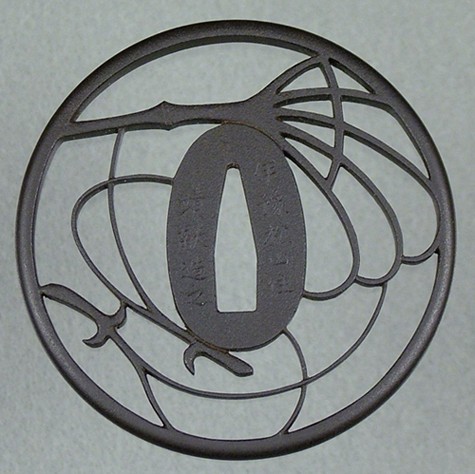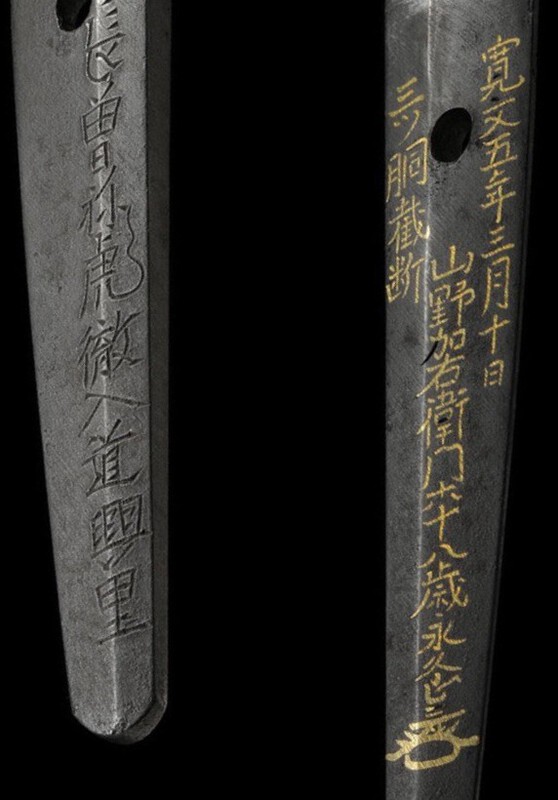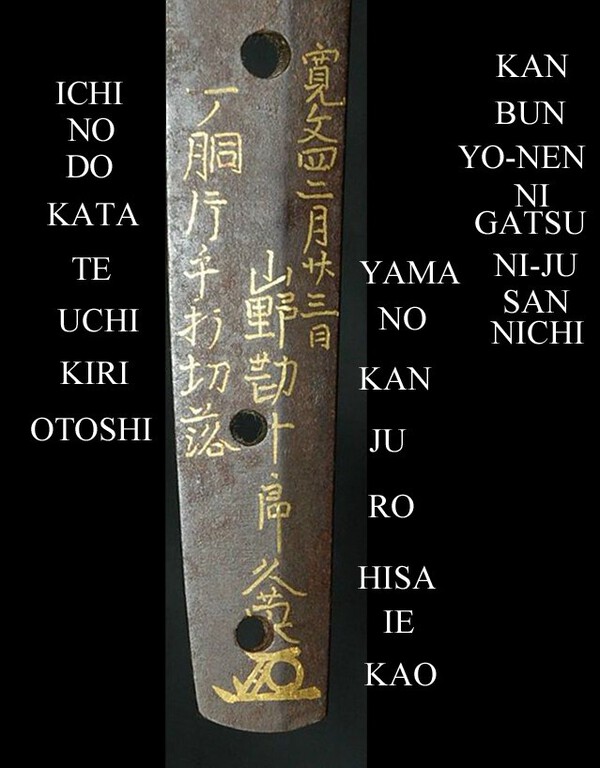-
Posts
1,785 -
Joined
-
Last visited
-
Days Won
43
Everything posted by Ed
-

Bizen Osafuné Koshiraé display
Ed replied to Bugyotsuji's topic in Sword Shows, Events, Community News and Legislation Issues
Great Koshirae, great photos. Thanks for sharing. -
This is obviously an oil quenched, non-traditionally made sword. There were several "Kanemoto" working in the Showa period (1926-1989). I remember there were a couple of Rikugun jumei tosho and maybe one Kaigun jumei tosho. At any rate this is NOT the famous Kanemoto you are hoping for. Probability 99.9999%.
-
Special thanks to Brian who has diligently stayed the course of maintaining this site for years now. You have done a great job. While I fade in / fade out at times, I have always thought highly of the NMB and what it has accomplished.
-
-
Cruising around here today and saw this thread which has been active quite a while. Piers, I took these atop Himeji Castle
-
I thought I did, but can't find them. I will take some additional photos in the next day or so.
-
Tom, Sorry for the confusion, don't know what I was thinking this morning, must have been still half asleep. I have corrected them. The first one, yatsuhashi is Toshiyuki, Tamaoka Toshiyuki. The second one, rake and pine needle, is by sword smith Matsuyama Seiken.
-

So what's a weird deal-breaker for you?
Ed replied to Brian's topic in General Nihonto Related Discussion
It happens, but is not limited to rednecks. Pretty much anyone that is relatively new to the hobby, unknowledgeable or perhaps unconcerned with history, preservation, etc. I once sold a katana to an attorney in Philadelphia who later wrote to inform me he had bent the blade while cutting mats in the back yard. He even included a video which depicted the sordid event. -

So what's a weird deal-breaker for you?
Ed replied to Brian's topic in General Nihonto Related Discussion
A pet peeve of mine for sure. Not limited to dealers, but anyone that writes. -

Um....Has anyone heard from David McDonald?
Ed replied to Professor Zhirinovsky's topic in General Nihonto Related Discussion
I saw him just a couple of weeks ago at the Chicago show. He stays pretty busy, I wouldn't worry. -
If you would even consider buying this POS, you should put buying "on hold" and spend some time studying. Spend that money on books!
-

Cutting Tester Mei with Kakihan (Kao) - A Survey
Ed replied to Bruce Pennington's topic in General Nihonto Related Discussion
Bruce, You are correct, that is Hide. Not sure how that typo was never point out or corrected before now. Best, Ed -

Cutting Tester Mei with Kakihan (Kao) - A Survey
Ed replied to Bruce Pennington's topic in General Nihonto Related Discussion
-

Cutting Tester Mei with Kakihan (Kao) - A Survey
Ed replied to Bruce Pennington's topic in General Nihonto Related Discussion
-

Cutting Tester Mei with Kakihan (Kao) - A Survey
Ed replied to Bruce Pennington's topic in General Nihonto Related Discussion
Order direct from LuLu: https://www.lulu.com/en/us/shop/markus-sesko/tameshigiri-the-history-and-development-of-Japanese-sword-testing/hardcover/product-1nw5yeer.html?page=1&pageSize=4 -
Wow! There are some really great tsuba in this thread. Scrolled up and down, up and down trying to pick a favorite. Can't settle on just one. I only picked up a few this year, a nice Soten, an Akasaka Tadashige made at age 73 and a Tokuho Kanayama.
- 64 replies
-
- 12
-

-

-
Ok, let's nitpick, exactly why I didn't want to answer the question. Porous areas. Around the inlays, between plates, microscopic cracks, loose grain, etc., etc. There are areas where oils and such can penetrate.
-
Just boiling. No chemicals added.
-
I hate to provide an answer to this as it is certainly debatable and there are always opposing views. First, let me say that oiling a nakago is not the same as cleaning it. Opposing views exist on this as well. You asked about the chemistry involved when boiling a tsuba, here it is: Boiling produces endothermic reaction which converts rust (Hematite fe2 03) to mill scale (Magnetite fe3 04). My opinion and that is all it is, my opinion, is that boiling may remove some of the "stuff" inside the sukashi. Which is why I will reiterate: The best advice for most tsuba is, leave them be. I have only boiled a few and only when I found it absolutely necessary in order to preserve the tsuba. I personally prefer to send any tsuba I feel needs this amount of preservation to a pro like Brian T. As far as eating away the inside of the sukashi. Like the outside, the inside has a good patination layer on it and was most likely oiled, waxed or lacquered at the time it was made, which helps to protect it. No amount of patination or protective coating can withstand hard use, severe abuse and/or long term exposure to the elements without some degradation. This is why we see the occasional tsuba with severe rust damage or complete deterioration to the thin sukashi elements and as well as the rim or seppa dai. On the other hand you see the majority of tsuba which are completely intact with minimal or no damage. Others which were cherished and meticulously cared for may be several hundred years old and yet are pristine. Hope this helps. Ed
-
I wrote this some time ago: TSUBA CARE: CLEANING IRON TSUBA The following recommendations have been around for years. I am not “writing the book” on the subject, this is for the most part a summary of the article Jim Gilbert wrote some years ago. I have simply put the information together in what is hopefully an easily read, easily understood guide as well as added a few additional suggestions for cleaning your tsuba. The best advice for most tsuba is, leave them be. *Anything other than a simple cleaning should be done by a professional. Occasionally you obtain a tsuba that is in very poor condition. A tsuba encrusted with layers of old waxes, oils, lacquer, rust, dirt along with various chemicals or compounds which have been applied over the years. In these cases, cleaning may be required for preservation. Preservation not restoration!! Leave restoration to the professionals!!! NOTE: You can damage the original patination with either the carding or the boning if overdone. Remember, this is for IRON tsuba only. Do not attempt to clean soft metal tsuba. Patination on soft metal is much more susceptible to damage. *DISCLAIMER; Before proceeding I want to make a couple of things abundantly clear regarding cleaning iron tsuba: NEVER use chemicals or abrasives of any kind! (this includes tea or coffee) NEVER use wire brushes of any type (no steel, brass, copper)! NEVER use metal of any type for boning! NEVER use an old piece of carpet for carding! Carpet contains numerous chemicals and can leave an oily residue. NEVER clean the inside of the sukashi! This is like cleaning the nakago on your swords. NEVER over clean the tsuba! NEVER rush, take your time! NEVER attempt anything more than simple cleaning. NEVER use these steps for Kinko (soft metal) tsuba! ALWAYS dry thoroughly after washing, using a hair dryer or heat gun! *Iron exposed to H2O and O2 produces oxidation = rust or hematite ie; iron oxide Fe2O3. Ok, let’s get started. Successive steps will result in the least amount of intervention required to clean your tsuba. These have been the steps for cleaning for as long as I have been collecting. First, simply wipe or rub down your tsuba with a piece of heavy cotton material. This is known as carding. A clean piece of old “blue jeans” works well and will remove more dirt, rust and grime than you might imagine. A lot of people used to put their tsuba in the back pocket of their jeans and let the natural movement of walking card the tsuba. I like to rub mine while watching TV (the tsuba). Second, carding alone will not remove years of soaked in oils or waxes that may have been applied. Next, try washing your tsuba with hot water and a mild hand soap. Do not use detergents or dishwashing liquids as they are very harsh. I have always had good luck with plain unscented Ivory bar soap. An old “soft” toothbrush can be used to gently nudge rust, grit and grime from the surface. Third, did the hot water, soap and toothbrush remove most if not all surface grime. The big question is, did it draw out the years and years of oils or wax which may have penetrated deeply into the steel?? Is there any way to tell? Not really. So, what’s next? Boil your tsuba in distilled water. Yes, that is correct, boil the tsuba in distilled water for approximately 30 minutes. This will open the pores in the steel and allow the remaining oils or wax to be purged from the iron. Boiling will not damage iron tsuba! The only exception may be tsuba with gold foil applied to cross hatches on the surface, or Nunome zogan. Vigorous boiling could potentially loosen or remove this type of surface application. *Note: Boning or carding could potentially remove nunome as well. In other forms of inlay such as Iroe, the inlay is pressed into grooves carved into the plate. The raised edges are then hammered back down onto the inlay material for a very strong bond. *Note: If I have a tsuba which I deem needs more than the first step of carding only, I reverse steps two and three and start with the boiling. I like to go ahead and boil the tsuba first, then when it cools enough to hand wash gently with the soft toothbrush, mild soap and hot water. I have found that 90% of tsuba which have been oiled or waxed over the years, end up requiring the boiling step to rid them of all oil and wax, and boiling them won’t hurt them. In fact, the agitation of the boiling water can aid in loosening and removing red rust which may be present. NOTE: You can damage the original patination with either the carding or the boning if overdone. BONING: Once your tsuba has been cleaned and dried thoroughly, the next step is taking a good look at it under a bright light source like halogen or daylight fluorescent. If the sun is out, look at it in direct sunlight which works great. This will enable you to see any red rust which may need to be removed or minimized. Ivory scrap is the best for boning, but it is difficult to find. Old piano keys are a good source. Bone will work also. You will need various sizes and shapes. NOTE: You can damage the original patination with either the carding or the boning if overdone. Gently remove the rust with the bone, then wipe with a damp cloth. Repeat the process until the rust is mostly gone. Remember, the goal is to stop active or red rust, not to make the tsuba look brand new. It is easy to get carried away with this process and do more harm than good. I will reiterate, for most tsuba, leave them be! In my 25+ years of collecting I have only used more than carding with a cloth on maybe 10 tsuba, maybe. When there is doubt seek the advice of a professional prior proceeding. As collectors, we assume responsibility for proper preservation of these antiques. *Good intentions are meaningless unless followed by responsible actions! *

















